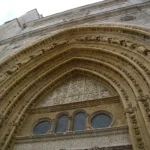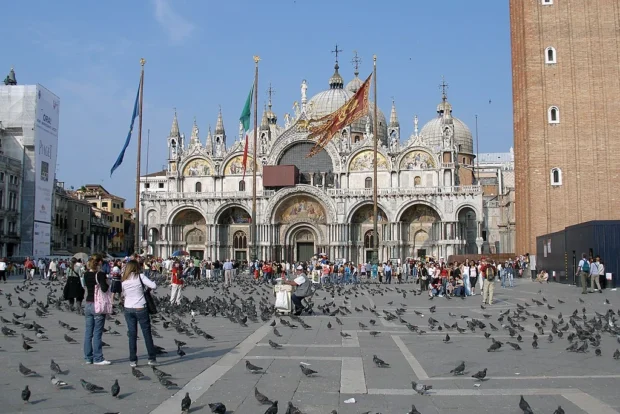Venice, Italy, stands as a living museum where history, art, and architecture entwine effortlessly. Among the city’s masterpieces, St. Mark’s Basilica commands attention with its shimmering mosaics, Byzantine domes, and extraordinary craftsmanship. This iconic cathedral not only serves as a profound symbol of Venice’s religious and political power but also enchants visitors with its layered history and intricate design. Whether arriving from Venice’s historic train station, Marco Polo Airport, or simply strolling through the city’s labyrinthine canals, St. Mark’s Basilica offers an unforgettable glimpse into Venice’s past and architectural soul.
Table of Contents
Finding Your Way to St. Mark’s Basilica
Positioned in the heart of Venice’s famous Piazza San Marco, the Basilica acts as a focal point amid the city’s dense network of canals and narrow walkways. If you arrive at Venezia Santa Lucia train station, the easiest route involves a scenic 30-minute walk through charming alleys and over iconic bridges like the Rialto Bridge. Vaporetto (water bus) lines 1 and 2 also provide direct service to the San Marco stop, allowing you a picturesque ride along the Grand Canal.
From Marco Polo Airport, water taxis or buses can transport you to the city center. Taking a vaporetto from Piazzale Roma to San Marco offers a pleasant introduction to the city’s aquatic transport system, combining convenience with stunning views. Upon arrival at Piazza San Marco, the Basilica’s gleaming domes and gilded facade stand unmistakably before you.
The Architectural Grandeur and Historical Significance
St. Mark’s Basilica represents a sophisticated blend of Byzantine, Romanesque, and Gothic architectural styles. Originating in the 9th century to house the relics of Saint Mark the Evangelist, the church quickly became a potent symbol of Venetian authority and spirituality. Over centuries, Venetian rulers enriched the structure with precious stones, golden mosaics, and imported marbles, a testament to the city’s mercantile wealth and cosmopolitan connections.
After immersing yourself in Venice’s rich religious architecture, you might enjoy seeing how the Blue Mosque’s stunning domes and spiritual calm define Istanbul’s skyline.
The basilica’s five large domes crown the structure, each adorned with intricate mosaics that narrate biblical stories and Venetian myths in a sparkling kaleidoscope of gold and glass. The Pala d’Oro, an extraordinary altarpiece encrusted with sapphires, pearls, and garnets, exemplifies the mastery of medieval goldsmiths and remains one of the most revered treasures inside.
Craftsmanship and Design Details
Every corner of St. Mark’s Basilica reveals layers of artistic endeavor. The exterior horseshoe arches, borrowed from Eastern architecture, contrast with Western Gothic pointed arches, symbolizing Venice’s position as a crossroads of cultures. The mosaic floors, often overlooked, display geometric patterns and iconography that emphasize both sacred and civic themes. Observing these details up close rewards visitors with a profound appreciation of medieval artisanship and Venice’s unique historical context.
Optimal Visiting Times and Practical Tips
The Basilica welcomes visitors every day, but timing your visit can dramatically improve your experience. Early morning hours, just after opening, provide a serene atmosphere before tour groups arrive. Weekdays, especially Tuesday through Thursday, tend to be less crowded than weekends.
Avoid peak tourist seasons in late spring and summer if you prefer calmer surroundings; late autumn and winter offer a quieter ambiance but be prepared for shorter daylight hours. If you wish to witness the basilica during religious ceremonies or the spectacular illumination of its mosaics by candlelight, check the official calendar for special events.
How to Dress and What to Bring
St. Mark’s Basilica remains an active place of worship, so visitors must dress modestly-shoulders and knees should be covered. Comfortable walking shoes are advisable because the stone floors can be uneven. Photography is allowed in certain areas without flash, so prepare accordingly if you wish to capture the intricate mosaics and architecture.
Reservations and Guided Tours
Due to the basilica’s immense popularity, booking tickets in advance is highly recommended. While entrance to the Basilica itself is free, access to museum areas like the Pala d’Oro, Treasury, and the rooftop terraces requires tickets. Online reservations not only save time but also allow visitors to plan an in-depth exploration of these exceptional spaces.
Joining a guided tour enriches your visit significantly. Expert guides illuminate the complex iconography of the mosaics, the history behind the structure’s successive additions, and the fascinating stories of Venice’s past rulers. Audio guides and multilingual tours are also available, catering to diverse visitors.
Nearby Accommodation and Local Flavors
Around Piazza San Marco, several charming accommodation options cater to different tastes, from boutique guesthouses to elegant lodgings housed in historic palaces. Staying nearby means waking up to the soft sounds of gondoliers and morning markets, offering an authentic Venetian start to your day.
After visiting the Basilica, sample traditional Venetian cuisine at nearby bacari, small taverns known for their cicchetti (Venetian tapas). Try local specialties like sarde in saor (sweet and sour sardines) or fresh seafood risotto. For a refreshing break, sip a spritz-Venice’s most famous aperitif-while gazing at the lively piazza.
The Basilica’s Surroundings and Urban Context
St. Mark’s Basilica anchors Venice’s political and cultural center. Adjacent to it, the Doge’s Palace displays opulent Renaissance architecture and political history, offering a striking contrast to the Byzantine stylings of the Basilica. The square itself, framed by the Campanile and Procuratie buildings, forms a perfect setting for architectural photography and people-watching.
Urban morphology enthusiasts will appreciate how the piazza forms a central node from which Venice’s canals and streets radiate. The careful preservation of the fabric surrounding the Basilica ensures that the visitor’s journey through time remains uninterrupted.
For a broader look at Venice’s enchanting streets and hidden corners beyond St. Mark’s Basilica, Wandering the Canals and Culture of Venice with Open Eyes offers vivid scenes of daily life and lesser-known treasures.
Official Resources and Further Reading
For the latest information on opening hours, ticket reservations, and guided tours, consult the official website of St. Mark’s Basilica. This resource provides detailed visitor guidelines and updates on restoration work that preserves this extraordinary monument:
St. Mark’s Basilica

- St. Mark's Basilica, St Mark's Square, Venice, Italy by Vyacheslav Argenberg on Wikimedia Commons – cc by 4.0
